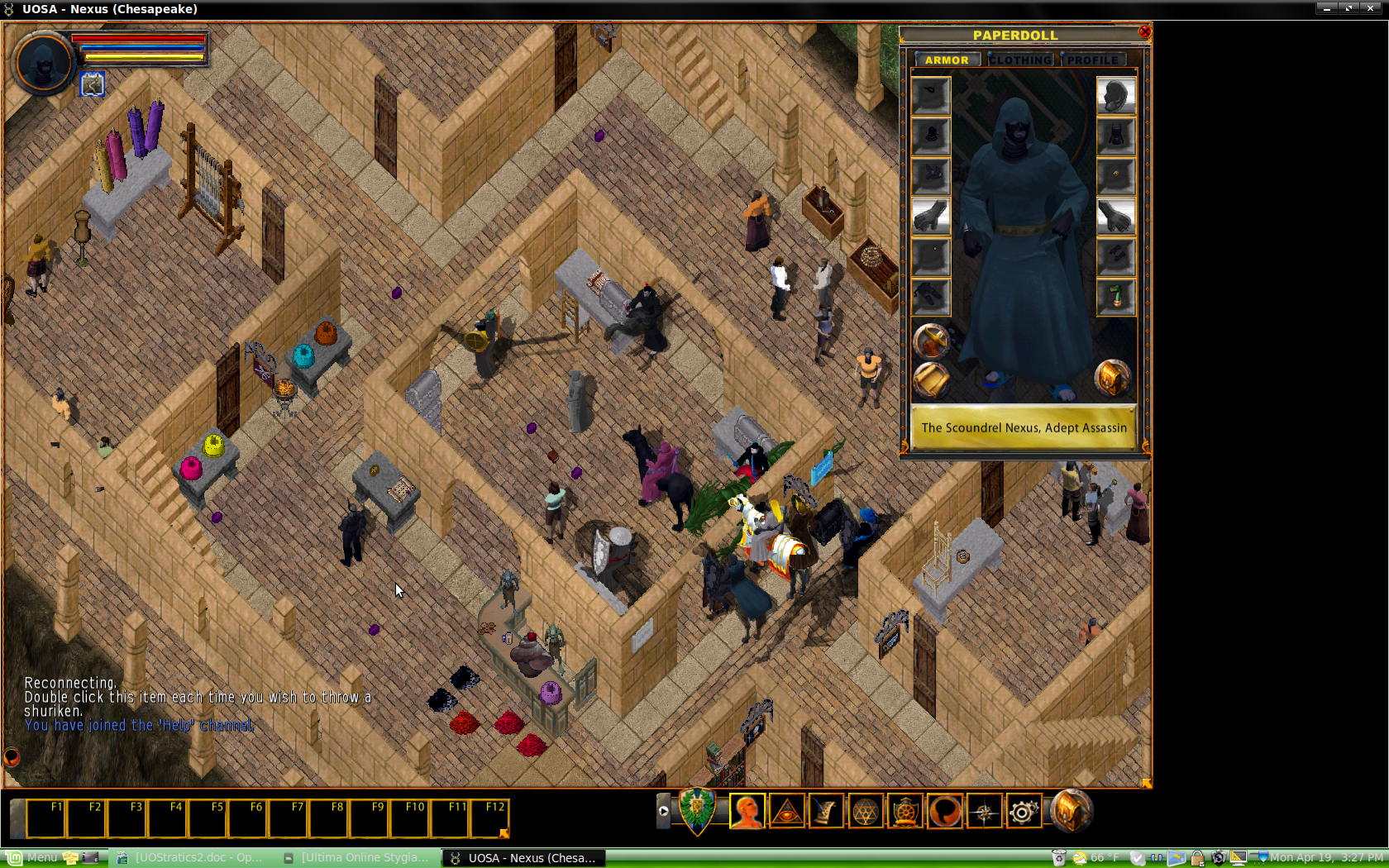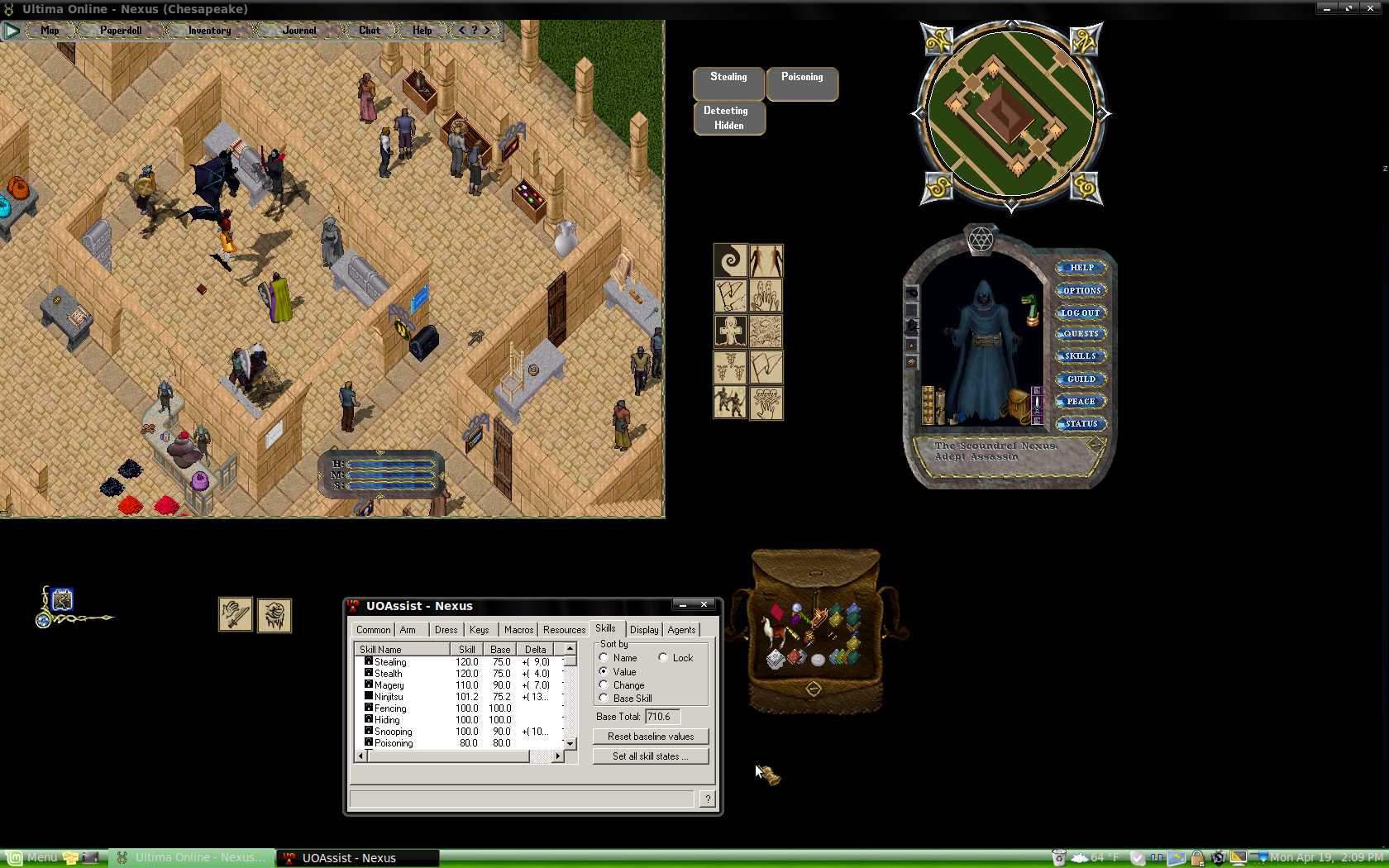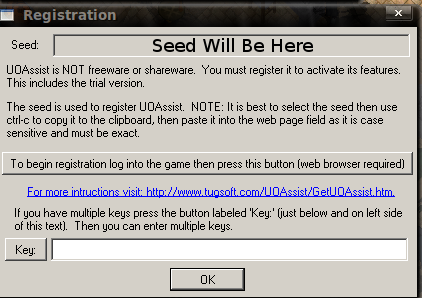Ultima Online on Linux
Return to: Technical InformationUltima Online on Linux Orginal Guide by Hugo of Napa Valley, Updated Guide by Nexus of Chesapeake, April 2010.
Ultima Online: Penguin Powered
In this article I plan to help the Linux user properly setup and install WINE, Winetricks, Ultima Online (Both Legacy and Enhanced Clients if desired), and UOAssist. I personally use a Debian Based Distro called Linux Mint currently on release 8 often simply referred to as “Mint Helena”, if you are using a RedHat, Slackware, openSUSE, FreeBSD or any other distribution model I’ll give links to all the software developers pages used in this guide, and ask that for non-Debian based users, please Read the Installation Instructions of these pieces of software when necessary. Additionally if you are a Mac user the instructions for installing Ultima Online on a Mac should be similar to these, with necessary changes due to Mac OS’s differences. WINE Most major Linux Distributions will come with WINE pre-packaged, while this is a good thing most use WINE 1.0 and not the latest release. To fix this there are several options, first you can go to your distro’s package manager such as Synaptic and do a search for WINE and install WINE 1.2. Or you can simply open a Terminal and enter the following command: sudo apt-get install wine1.2 You should at this point be prompted to enter your super user password do so and hit enter and wait till WINE has completely installed. You should have a new option on in your menu’s called “Wine”. Please search through it and find the “Configure Wine” link and open it. Use the drop down Menu on the window that opens to set the Windows Version (located at the bottom of the window) to Windows XP, as I’ve found it works best with the rest of this guide. For non-Debian users please go to http://www.winehq.org/download/ and find the installation instructions for your distro. Winetricks is an add-on to simplify installing many pieces of software for use with WINE, I recommend installing Winetricks as it is extremely useful in setting up Direct X for WINE. wget This will download Winetricks, to run it type in the following in your terminal: You should get a popup with a list of software available to be installed, for this tutorial go ahead and go through the list and check corefonts, d3dx9, d3dx10, and fontfix. Click OK and winetricks will set up Direct X 9 and 10, install and setup the basic Windows Fonts to help with graphical errors in text on your Windows Forms when running programs with WINE. Ultima Online Legacy or Enhanced Client My how times have changed, it is now as easy or, easier to install Ultima Online’s Enhanced Client with WINE than it is to install the classic or legacy client, that is unless you have access to a legacy client install on another computer you can copy over, or a Ultima Online CD you can install and patch to the latest version. To make things easy I’ll start with instructions on how to install the Enhanced Client first, and then help with the Legacy Client. Enhanced Client Setup step by step as taken from. http://appdb.winehq.org/objectManager.php?sClass=version&iId=17380&iTestingId=45078 The above link is the official entry on WINE’s app database, where you can look up and search for windows based software to check on compatibility with WINE. This method does work I have verified it myself, it can be annoying at times to accomplish but well worth it if you prefer the Enhanced Client.
Note: If you run into patching errors, make sure you don’t have more than one copy of uopatch.exe running. While that helps getting uopatch.bin to start, it causes errors DURING patching. You may have to kill the process and restart.
The Legacy client now uses a much different installer than in the past, but it can be installed on Linux. First Download the new installer and then right click the download and “Open with WINE Windows Program Loader”. The setup will start just like on Windows, if it crashes don’t worry because Linux and Wine operate differently than Windows, it is much easier for a program to basically “hang up”. If you absolutely cannot get Ultima Online to install with the new installer, you still have options. You can see about obtaining a copy of Ultima Online that is already installed on another computer and then copy this into the .wine/drive_c/ directory located in your home folder. If you can’t find .wine when you open your home folder don’t worry it’s there, it is a hidden directory just click View and check the box for Show Hidden Files. Another option is if you have a UO Installer Disk, simply pop in the disk, browse the disk contents, and right click Setup.exe and choose “Run with WINE Windows Program Loader”. You’ll have a lot of patching to do but it should install without issue.
Illustration UOAssist A couple of years ago if you wanted UOAssist to work with Linux you were pretty much out of luck. These days thanks to improvements to WINE it is now possible, with a little bit of extra work. First off you’ll need an install of IE6 or IE 7 which is easy enough to manage if you use winetricks (see I told you it’s a useful program). Simply enter “sh winetricks” in a terminal hit enter and select IE6 or IE7 from the pop-up menu. Now go to the Tugsoft website and download a copy of the UO Assit installer. Open the downloaded installer by right clicking it and picking “Open with WINE Windows Program Loader” and when prompted navigate to your Ultima Online Install folder, usually it is /home/[your user name]/.wine/drive_c/Program Files/Electronic Arts/Ultima Online Stygian Abyss Classic. Let the install finish and then run UOAssist from the WINE section of your Menus. Don’t click Continue on the UOAssist window yet! Instead pick “Settings” in the lower Right corner of the window and set UOAssist to Load with “Method Three” as this is more stable on Linux distributions. If you already have a UOAssist registered account you can recover your key by copying the Seed from the Registration Menu and then manually pasting it into the box on the Tugsoft Locate Key page.
Illustration At this point you should have a working Ultima Online Installation, and if desired UOAssist operating on Linux, along with some other helpful software such as winetricks, that not only helped you get UO set up, but will be useful in the future. Other Options If you don’t want to install WINE and would prefer a more fleshed out Windows compatibility Layer you can look into purchasing a license and installing Cegeda. Cegeda is a fork in the WINE project and at one point absorbed the WINEX project. Dual Booting, if you have a valid windows installation but also want to use Linux, it’s easier than ever to set up a Dual Boot System. The latest versions of the GRUB boot loader will automatically detect for Windows installations and configure a boot loader for you during it’s (GRUB’s) installation. This makes switching back and forth as easy as restarting your PC. Several Linux Distributions now also include something called a wubi on their Live CD’s this allows you to install that version of Linux from inside Windows, this makes installing Linux even easier, and it can be removed like any other windows based program through Add/Remove Software in the Control Panel. To switch from Windows to Linux, just reboot. VMWare, I hope this guide has been helpful to those of us that Don’t wish to rely on Windows, or for those that are interested in making the switch to a Linux distro, but were concerned about their ability to continue playing Ultima Online. So without further ado, Well met and see you in Britannia! |
Last modified: September 13, 2013












I installed UO as described above. I ran the patcher and such just fine. Game started but text boxes were flashing and buildings wouldn’t render. Players, creatures and music worked just fine, but was unplayable. Help?
1I’m sorry, I’m unable to help you with this, please seek advice here: http://stratics.com/community/forums/uo-tech.455/
2